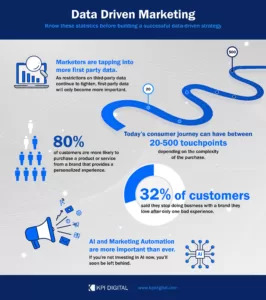Data-Driven Marketing Trends in 2022
According to McKinsey & Company 64% of marketing executives “strongly agree” that data-driven marketing is crucial in today’s landscape. Below are some of the most important trends to consider when forming your strategy.
1. Marketers Will Tap into More of Their First-Party Data
In an effort to reduce spam and email overload, regulations like GDPR and CASL have cut down on a marketers’ ability to capture and use third-party data. In response, marketers are turning to data that they’ve captured from their own audiences, such as CRMs, website visitors, social media followers, email subscribers, transaction records, and phone calls. This vast amount of unstructured data contains a wealth of opportunity, if mined and analyzed strategically. As restrictions on third-party data continue to tighten, first-party data will only become more valuable.
2. More Touchpoints are Involved in the Buying Journey
Today’s consumer journey is more fractured than ever before. In fact, a recent study from Google found that today’s consumer journey can have between 20-500 touchpoints, depending on the complexity of the transaction.
Consumers have higher expectations so it’s critical that your data-driven approach unifies disparate channels and creates a cohesive brand experience for each consumer. Failing to do so risks increasing churn, along with lost loyalty and revenue.
3. Consumers Have Higher Expectations for Personalization
As marketers capture first-party data from more touchpoints than ever, consumers expect great experiences in return. In fact, 80% of customers are more likely to purchase a product or service from a brand that provides personalized experiences. Customers now expect more from brands in general, including highly customizable journeys that go well beyond a simple transaction for products and services.
4. Brand Loyalty Is Fading
In 2022, you cannot rely on unrequited brand loyalty. Marketers must ensure that they deliver a seamless experience to every customer on every channel — otherwise, they’re only a click or call away from choosing a competitor. In a recent study, 32% of customers said they stop doing business with a brand they love after only one unpleasant experience.
5. AI and Marketing Automation Are More Important Than Ever
To scale personalization, marketers are depending more on AI and automation solutions. Leading marketers are leveraging AI for everything, from optimizing ad bidding; to targeting audiences; to personalizing web experiences; to capturing insights from phone conversations at scale. Watch out: if you’re not investing in AI now, you’ll soon be left behind.
What Insights Do Data-Driven Marketers Need in 2022?
With recent third-party data restrictions, marketers are shifting to first-party data sources. A recent survey found that 82% of marketers plan to increase their use of first-party data.
Below are some of the most valuable sources of first-party insights that data-driven marketers are leveraging in 2022.
1. CRM Data
With CRM data, you can segment your audience based on all their past interactions with your brand and tailor their experiences to align with their journey and buying intent.
2. Web Analytics Data
Web analytics tools like Google Analytics and Adobe Analytics capture data about consumers’ interactions on your website. With this information, you can personalize their experiences based on the pages they have visited and online goals they have completed.
3. Mobile App Data
Like your website, your mobile app can give you deep insights into your consumers’ interactions with your brand. Google Analytics 4 offers new features that makes it easier than ever to capture mobile app data. You can now see how users spend their time on your app, their favorite features, common conversion paths, and more. You then can use this data to optimize your app’s performance and personalize user experiences.
4. Transaction Data
Capturing and leveraging data from transactions is critical. By understanding what consumers have purchased, you can predict what they would be inclined to purchase in the future, and tailor their experience accordingly.
5. Call Tracking and Conversation Intelligence Data
In addition to understanding consumers’ online interactions with your brand, it is equally important to understand how they’re engaging with you over the phone. It’s important to connect the messaging and channels driving calls. Using AI to analyze the content of conversations at scale is important; Was it a sales lead? What was the caller’s buying intent? Did the call convert to a sale? This data fills in a critical blind spot and allows you to personalize consumer experiences in creative, innovative ways.
